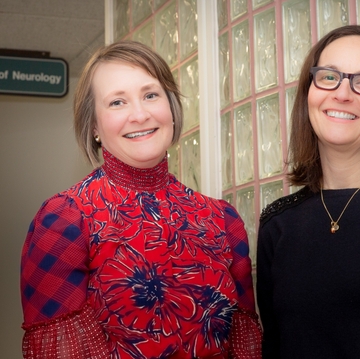New Mexico Approves Master of Science in Anesthesia Program at UNM

Maintaining Mobility
UNM Planning New Comprehensive Movement Disorders Center
More than 10,000 New Mexicans suffering from movement disorders could have access to new therapies and a broader range of services if the New Mexico Legislature decides to fund a new comprehensive movement disorders clinic at The University of New Mexico Health Sciences Center.
The university is seeking $3.5 million from the state (to be matched by a like amount from internal funding) to construct a dedicated 16,000-square-foot clinic, says UNM's Amanda Deligtisch, MD, an associate professor in the Department of Neurology.
"This is a building that's designed to have appropriate access, with handicapped parking out front and shorter and wider halls," Deligtisch says. "These are all features that would benefit any type of patient with a movement disorder."
An additional $1.3 million in requested program funding would support new providers and support staff, including nurses and nurse practitioners, social workers, case managers, research coordinators, psychologists, neuropsychologists and physical and occupational therapists.
"It's about access and the ability to coordinate the care, thoroughly and completely, in a timely way for patients," Deligtisch says. "There's a lot more that can be done outside of the direct medical evaluation and medical management of patients with movement disorders when we have this comprehensive multidisciplinary approach."
The facility would also allow for trials of new treatments and therapies and could one day become a center of excellence for the treatment of Parkinson's and Huntington's. Currently, Deligtisch says, "there's really limited to no access to clinical trials for movement disorders patients in New Mexico."
Movement disorders place a heavy burden of disability on patients and their families. Parkinson's disease, which accounts for about 5,300 cases in New Mexico, is most prevalent. Other forms include dystonia, essential tremor, Huntington's disease and ataxia. These disorders tend to afflict older people, so the number of sufferers is expected to grow as New Mexico's population ages.
Significant new treatments for Huntington's - and perhaps Parkinson's - lie on the horizon, Deligtisch says, but specialized knowledge leads to better patient outcomes. Like her UNM colleague Sarah Pirio Richardson, MD, Deligtisch underwent movement disorders fellowship training following her neurology residency. Only one other neurologist in the state has similar training.
A comprehensive movement disorders center would also help attract additional specialists to practice in New Mexico, Deligtisch adds. With current caseloads, patients must wait from six to nine months to be seen by UNM neurologists, with a six-month delay for follow-up visits.
The 2018 Legislature passed a memorial urging the UNM Health Sciences Center to explore the creation of a dedicated movement disorders center, due in large part to support from the Parkinson's Coalition, and former UNM Regent Jamie Koch, who spoke about his own Parkinson's diagnosis.
"This isn't a hard story to sell," Deligtisch says, noting that many New Mexicans know someone with Parkinson's or another movement disorder. "Everybody gets this."
Photo: Allan Stone